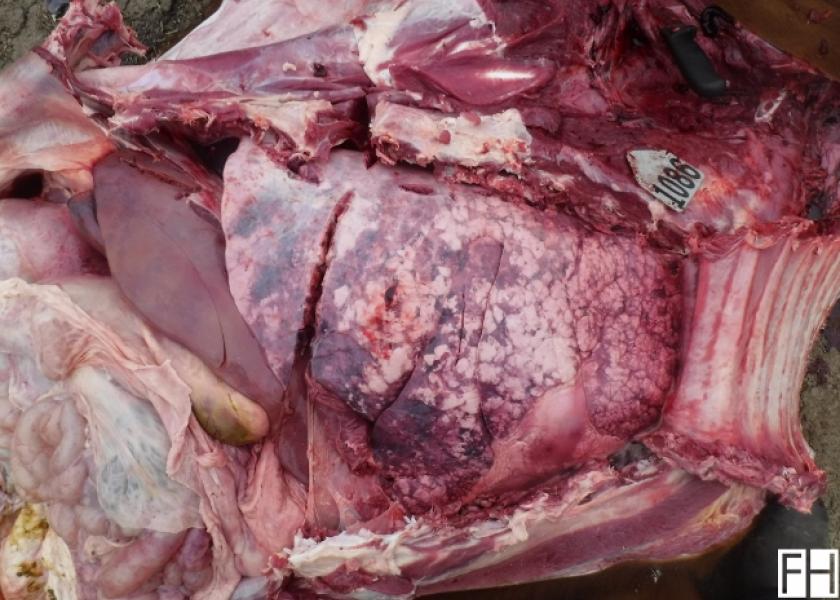Post-Mortem in a Feedlot Heifer: Answer

The team diagnosed this case as a representative example of Atypical Interstitial Pneumonia (AIP), a costly and frustrating syndrome that affects feedlot cattle in North America.
Pathogenesis:
While the exact pathogenesis of feedlot AIP has not been elucidated, epidemiology and sampling projects suggest a metabolic (or “digestive disease”) component. Some aspects of the disease are similar to the well described disease in mature cows, acute bovine pulmonary edema and emphysema (ABPEE, also known as “fog fever”). However, ABPEE does not fully explain the pathogenesis of feedlot AIP.
Epidemiology:
• More commonly observed in cattle later in the feeding period than early in the feeding period
• Seems to happen more frequently in the summer months (June – August) than other times of the year, but this is confounded by days on feed and lower occurrence of other causes of death
• More common in heifers than steers
Ante-Mortem Clinical Signs:
• Open-mouth breathing (dyspnea), frothing of saliva, the head and neck extended an open shouldered stance
• Breathing is shallow and rapid
• Typically, absence of cough and fever (less than 104°F)
• Ante-mortem diagnosis is acute interstitial pneumonia or acute respiratory distress, the exact cause of which may be challenging to determine in the live animal as it is difficult to differentiate this disease from other lower respiratory tract issues that can cause acute respiratory distress, even when using clinical history and signalment (days on feed, previous treatment history, etc.)
• Case fatality rates may be upwards of 50% in animals with AIP
Management:
• General management/treatment typically centers around treatment with potent anti-inflammatory drugs and/or salvage slaughter
Post-Mortem Lesions:
• Post-mortem examination is paramount to correctly identify the cause of death and confirm AIP
• Upon initial observation of the open thorax (Fig. 1), typical findings often include: characteristic “patchy” appearance with intermixed hyperinflated and reddened lobules, lungs that fail to collapse, smooth parietal pleura without the presence of fibrin, and diffuse distribution of lesions throughout the lung (may tend towards a more caudal-dorsal distribution)
• Upon observation of the parenchyma on cut-sections of lung (Fig. 2), typical findings often include: characteristic “patchy” appearance with intermixed hyperinflated and reddened lobules, rubbery lobules that fail to collapse, and foam extruded from the airways

Additional lesions that may be present but are not observed in all cases: pulmonary edema observed as lobules separated by pale yellow interlobular edema, subpleural and interlobular and/or bullous emphysema, and occasionally mediastinal or subcutaneous emphysema (shoulder, neck, back)
 Feedlot Health’s large team of professional consultants serve feedlots and calf growers in Canada, the United States, Mexico, Brazil, Kazakhstan and elsewhere, representing about 4 million head per year. For more about Feedlot Health, see our lead feature beginning on page 8 of this issue.
Feedlot Health’s large team of professional consultants serve feedlots and calf growers in Canada, the United States, Mexico, Brazil, Kazakhstan and elsewhere, representing about 4 million head per year. For more about Feedlot Health, see our lead feature beginning on page 8 of this issue.
Working with crews at client operations, Feedlot Health conducts post-mortem exams on all feedlot and calf-grower mortalities, using a standard protocol for recording the animal’s history, digital images, and post-mortem findings. The group compiles images and post-mortem findings in a central database, for review by the professional team, as an educational tool and to track disease trends within an operation or across their client base.
For more information about Feedlot Health Management Services, visit their website at www.feedlothealth.com.
(Image credits: Feedlot Health Management Services)
Post-Mortem Series presented in partnership with Feedlot Health Management Services, Okotoks, Alberta.







